Jul 13, 2018
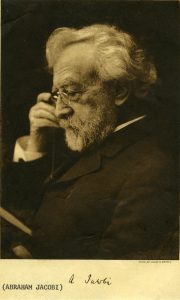
The Arthur H. Aufses, Jr. MD Archives at Mount Sinai is proud to make available two groups of digitized correspondence to and from Abraham Jacobi, MD (1830-1919), the “father of American pediatrics.” Dr. Jacobi was a towering figure both at Mount Sinai, where he chaired the Medical Board for twenty-five years and is the namesake of the Alumni Association’s Jacobi Medallion, and in the broader world of the history of medicine. He was the first Professor of Pediatrics at an American medical school (beginning at New York Medical College and later moving to Columbia), and under his leadership Mount Sinai created the first department of pediatrics at a general hospital in New York City.
This digitized collection is the work of two institutions, the Aufses Archives and the Historical Medical Library of the College of Physicians of Philadelphia, which generously made available scanned images of their own collection of Jacobi correspondence. By bringing together two geographically separated collections whose contents overlap in time and subject matter, this digitization project, which includes full transcriptions of all manuscripts, makes Dr. Jacobi’s story more accessible to scholars and the general public. The Mount Sinai letters are available here, and the Historical Medical Library’s letters are available here.
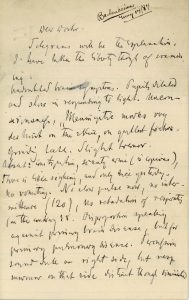
Although the majority of the collection deals with the staffing and administration of The Mount Sinai Hospital and its Out-Door Department (the outpatient clinics), one letter in the collection provides a fascinating glimpse into Dr. Jacobi’s medical practice. In 1884, at the request of an unidentified colleague, he examined an unnamed patient and replied with a brief but dense handwritten note describing his findings. Like modern physicians, Dr. Jacobi used close attention to his patient’s symptoms to perform a differential diagnosis. With no laboratories or high-tech equipment at his disposal, he relied solely on the evidence of his immediate senses, counting the pulse and percussing the chest to make a tentative diagnosis of secondary meningitis brought on by a pulmonary condition.
Dr. Jacobi comments that the “prognosis [is] bad, it is true — but still, who can tell?” His uncertainty tempered with hope reminds us that in hindsight, the decade of the 1880s was a pivotal time for modern medicine, when therapeutics had not yet caught up with rapid advances in accurate diagnosis. Nothing more is known of this patient or his eventual fate.
Jun 29, 2018
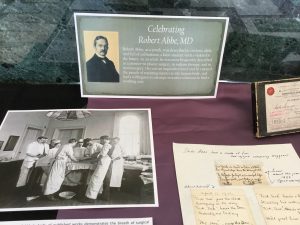 A new exhibit is now on display in the Mount Sinai West hospital lobby. Celebrating Robert Abbe, MD aims to share the many sides of Dr. Robert Abbe: the medical pioneer, the innovator, the artist, and the collector.
A new exhibit is now on display in the Mount Sinai West hospital lobby. Celebrating Robert Abbe, MD aims to share the many sides of Dr. Robert Abbe: the medical pioneer, the innovator, the artist, and the collector.
A native son of New York, Robert Abbe was born on April 13, 1851 and raised on Dutch Street in lower Manhattan. He attended public schools and took evening classes at the Cooper Union for the Advancement of Science and Art to develop his talents for drawing and painting. He earned an undergraduate degree from the College of the City of New York in 1870 and joined the faculty there after graduation, teaching Drawing, Geometry, and English. He completed an MD degree in 1874 from the College of Physicians and Surgeons, and spent his residency at St. Luke’s Hospital. He later became an Attending Surgeon there, as well as Roosevelt Hospital (now Mount Sinai West), the Cancer Hospital, New York Babies Hospital, Ruptured and Crippled (today’s Hospital for Special Surgery), and Woman’s Hospital.
As a youth, Robert Abbe was described as curious, alert, and full of enthusiasm, a keen student with a vision for the future. As an adult, he was most frequently described as a pioneer – in plastic surgery, in radium therapy, and in neurosurgery. His was an inquisitive mind and he enjoyed the puzzle of repairing injuries to the human body, and had a willingness to attempt inventive solutions to find a working cure.
On view in the exhibit is a small sampling of published articles by Abbe documenting the broad variety of surgeries he performed, including neurosurgery, treatments for various problems of the hand, gallbladder, and cancer of the cheek, jaw, and breast. Later in his career, he wrote on the use of radium in the treatment of various conditions.
Abbe continued to exercise his artistic talents into adulthood, not only as a fine plastic surgeon, but also as a painter. Ever curious to try new things, when the Lumiere brothers of France developed a new method for taking color photos using a glass plate and various salts in 1905, Abbe was quite interested. By 1907 it was available in the US, and Abbe was among the first to experiment with the method by photographing family and friends, producing some lovely images that have a delicate and painting-like appearance. Two of these images are on display in the lobby case.
Another of Abbe’s amusements was collecting documents and photographs of or about famous medical persons. He created scrapbooks on such notables as Louis Pasteur, Benjamin Rush, Edward Jenner, Joseph Lister, and Marie Curie. He also acquired several objects of these notables. Between 1911 and 1923 he donated this collection to the College of Physicians in Philadelphia. On display in the exhibit is a photograph of Marie Curie in her laboratory, and another of the quartz-piezo-electro meter, which she used to determine the strength of electron discharge from radium. In 1921, at Abbe’s prompting, she donated it to the “Abbe Cabinet,” as his collection is called, at the College of Physicians, where it remains on display.
The high esteem in which Abbe was held is documented by his 70th birthday celebrations, which were held at the New York Yacht Club and attended by many friends and relations coming together for a dinner in his honor. On display are two dinner menus for the evening, one of which was autographed on the back by several well-known physicians in attendance. Along with the menu is a bound volume of typed copies of letters he received on the happy occasion conveying best wishes and fond remembrances from colleagues, friends, staff, and former students from around the country. The book is opened to a letter from William J. Mayo, MD of the Mayo Clinic, who was among his students.
During his later years Abbe spent summers in Bar Harbor, Maine where he developed an interest in the Native American population of the area. He began collecting Native American tools and Stone Age artifacts he found. He dreamt of creating a museum to display his extensive collection, raised funds to do so and designed many of the exhibits himself. The museum opened only five months after his passing in 1928. A pamphlet from the museum is included in the exhibit.
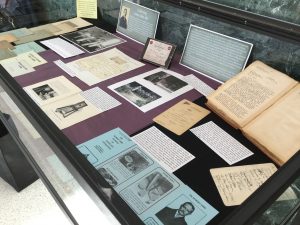 Please stop into the lobby at Mount Sinai West and browse the display, which is on view through October.
Please stop into the lobby at Mount Sinai West and browse the display, which is on view through October.
Jun 21, 2018
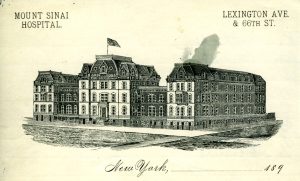
The second site of the Hospital on Lexington Avenue
This is an excerpt from the minutes of the Board of Directors of The Mount Sinai Hospital, March 11, 1888. It is a report from Mr. De Witt J. Seligman, a Director, concerning the proper verification of deaths occurring in the Hospital. The punctuation has not been changed. It provides an interesting view into what was then – and now – a very important issue: how to determine when someone is, in fact, dead.
“Mr. Seligman who was appointed a committee of one…read the following report:
To the Board of Directors of Mount Sinai Hospital:
Having been appointed at the last regular meeting of your Board a Committee of one to look into the matter of certifying to deaths I beg to submit the following report.
In getting at the facts of this matter I have seen three doctors of our visiting staff, the Pathologist of the New York Hospital, the House Surgeon and the House Physician of Mount Sinai Hospital and the Superintendent of Mount Sinai Hospital. There can be no doubt that it happens at times that patients are declared dead before life has become extinct. The Superintendent of our Hospital informs me that on one occasion a nurse told him that her patient was dead and that she was going to announce it to the doctor. The superintendent, Mr. Hadel, went to the Ward and found the alleged dead man sitting bolt upright.
A man informed our Superintendent, Mr. Hadel, that when he was a patient at Blackwell’s Island he was being carried from the Ward to the dead house. On the way they passed through the open air and the effect was that the man on the stretcher became revived and lived to tell this tale of carelessness to our Superintendent. Only this winter a relative by marriage of my wife was, I am informed, declared dead by a physician, but today that same man is as lively as a cricket. Had he been a patient of the Mount Sinai Hospital might he not under our present rules, have ·been hurried from his warm bed in the Ward into the death house and there frozen to death in a short time?
The Pathologist of the New York Hospital informs me that the Ambulance surgeon of the New York Hospital has been repeatedly in doubt as to whether a patient was dead or not and the same Pathologist of the New York Hospital tells me that a certain Dr. Ridlow thought a patient was dead and but two hours later the patient showed life; on the following day Dr. Ridlow again thought that the same patient was dead but even after that on the second day the patient showed life. There was in this case trouble with the heart. An intelligent gentleman connected with the Mount Sinai Hospital as a Director informs me that he and his wife have a mutual agreement by which in the case of the supposed death of one of them, the survivor is to carry out the following agreement: the word of the family physician is not to be taken that death has come but an outside physician is to be summoned to apply the death tests. After that is done no ice is to be placed on the body for 8 hours and the burial is not to take place for three days. In a large institution like ours where deaths are naturally occurring continually, the question arises, what method shall we adopt to avoid the possible mistake of hurrying a supposed corpse into the dead house where in case some life is still in the body it would soon by the sudden change of temperature be frozen out of the body.
One of our visiting physicians whom I saw suggested that the supposed corpse be placed in a warm room for 6 hours and that after 6 hours a second examination be made and then if no sign of life be found place the corps in the dead house. If decomposition has already set in this 6 hours additional precaution, the said visiting physician thought, ought not be taken, nor ought it be taken in warm weather when the cool temperature of the dead house would even aid to revive the flickering flame of life.
This idea seems to me the best idea that was suggested provided it be conscientiously carried out at the Hospital. But whatever rule you may make, one thing is sure and that is that no one but the House Physician on his side and no one but the House Surgeon on his side ought to make the death tests and in each and every case the House Physician or the House Surgeon ought to feel and bear the whole responsibility. To this end I would recommend that we have printed slips which shall run about as follows:
Mount Sinai Hospital, N. Y.
This is to certify that I have this day carefully examined __________________________
a patient of Mount Sinai Hospital in Ward No.____ Bed No.____ and found (him or her) dead.
These slips are to be signed only by the House Surgeon on his side of the Hospital and all these slips are to be kept by the Superintendent of Mount Sinai Hospital in a book for that purpose. In consultations with Drs. Rich and Walsh, the House Surgeon and House Physician of this Hospital, I find that there are no rules as to who shall declare that life has left a patient. Dr. Rich informed me that he always attended to this but Dr. Walsh informed me that in nearly all cases he did and in the remaining cases he left the investigation of the alleged corpse to any doctor, it mattered not which one.
The Pathologist of the New York Hospital informs me that at the New York Hospital the House Physician or the House Surgeon and nobody else testifies to death and even if he has been but a short time previous to death say three times at the bedside said House Physician or House Surgeon is personally compelled to go to the Ward and examine the patient after he has been declared dead. Even at night at the New York Hospital the House Physician or the House Surgeon is compelled to go to the body and examine it.
It may be of interest to you to know that at the New York Hospital every single corpse is washed and put in a shroud and as this operation usually takes half an hour or more, in the opinion of the Pathologist of the New York Hospital who gave me this information, is an additional safeguard against treating the patient as dead before life has left the body.
A great deal more could be written on this important subject, but I think I have written enough to make it clear that this Hospital should have the most stringent rules that can possibly be made in the matter of death certification.
Respectfully submitted
(signed) DeWitt J. Seligman
Mr. [Isaac] Wallach moved that the report of Mr. Seligman dated March 11, 1888 be spread on the minutes in full and that the recommendations contained in said report that the House Physician and House Surgeon must examine persons supposed to have died and sign certificates of death and no one else, in the manner suggested in said report.
That a book be provided for the purpose by the Comm. on Printing.
That the suggestion to place alleged dead persons for 6 hours in a warm room from and during cold months before such bodies are placed in the dead house be referred to the Executive Committee to provide the room if possible.
These provisions are intended as safeguards to prevent the slightest possibility of patients being placed in Dead House who may be apparently dead but not actually so. This whole motion of Mr. Wallach was adopted.
May 25, 2018
In 1875, The Mount Sinai Hospital selected Mary Putnam Jacobi, MD (1842-1906) to be the Chief of the newly established Children’s Clinic. Abraham Jacobi, MD, her husband, was an important member of the Mount Sinai medical staff and is today considered the Father of Pediatrics in this country. Still, the Trustees did not want him to be in charge of both the inpatient and outpatient services, so Mary Jacobi was appointed. All was well for some years, but in May 1884, the Board of Trustees’ minutes record the “continued absence and irregularity of Mrs. Dr. Jacobi in her duties in the Dispensary.” There was a motion seeking her resignation, but this was amended to instead send the president and vice-president of the Board to speak with “the delinquent” and report back. The subsequent meeting does not have a report on the visit with “Mrs. Dr. Jacobi,” but it is known that she resigned from the staff in October of 1886, more than two years later. Did being “Mrs.” Jacobi save her appointment? Perhaps. The very few other female doctors on staff were known as just Dr. The fact that Mary Putnam was married to Abraham Jacobi probably loomed large in the eyes of the Mount Sinai trustees. He remained associated with the hospital until his death in 1919.
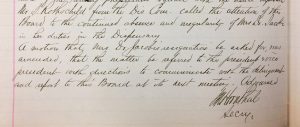
The minutes of the Board of Trustees of The Mount Sinai Hospital, May 1884
May 18, 2018
By some remarkable coincidence, many Mount Sinai Health System buildings have been dedicated or opened in May.
The Beth Israel Hospital opened its first facility in a rented loft in May 1890 and then moved to 196 Broadway the next year. In May of 1892 they moved again, this time to 206 E. Broadway and 195 Division St. Beth Israel remained at this location until the completion of the Jefferson & Cherry Street building in 1902. Beth Israel did not have another May opening until May 15, 1966 when the Linsky Pavilion opened.
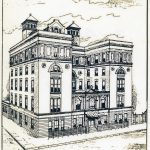
Beth Israel’s Jefferson and Cherry Street location
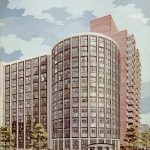
The Linsky Pavilion, which opened in May 1966
On May 17, 1855, a religious service was held to inaugurate the opening of The Jews’ Hospital in the City of New York, which became The Mount Sinai Hospital in 1866. Presiding at the inauguration was Rabbi J.J. Lyons, with Rabbis Leo, Sternberger, Rubin, Cohen, Waterman, Schickler and Tebrich serving as cantors.
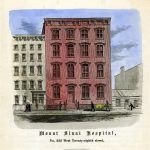
The original building of The Mount Sinai Hospital
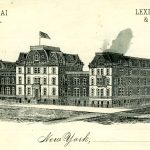
The second site of the Hospital
When Mount Sinai had outgrown this site, the Trustees decided to move uptown to the block of Lexington Avenue between 66th and 67th Streets. The cornerstone for the new hospital was laid on May 25, 1870 and the completed hospital was opened on May 29, 1872.

The 1904 building along 100th Street
Within 25 years, the Hospital had again filled its site and decided to move to its current home next to Central Park, between 100th and 101st Streets. The Park ensured that the hospital would not again get surrounded by the bustle of the City’s streets. The cornerstone for this new hospital was laid on May 22, 1901. In May 1922, Mount Sinai marked the completion of a massive expansion project that extended the hospital across 100th Street down to 99th Street. This included 1184 5th Avenue, which today is the oldest building on the Mount Sinai campus.
On May 23, 1952, The Mount Sinai Hospital celebrated the dedication of the Klingenstein Pavilion on 5th Avenue.
This was built as Mount Sinai’s Maternity Pavilion, and remains the home of our OB-GYN department. At the same event, the Atran Laboratory and the Henry W. Berg, MD Laboratory buildings were both dedicated as well.
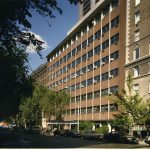
The Klingenstein Pavilion on 5th Avenue
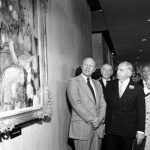
Vice President Ford and Walter Annenberg looking at the portrait of Mrs. Annenberg at the dedication in 1974
And finally, in perhaps Mount Sinai’s biggest dedication, on May 26, 1974, the new Mount Sinai School of Medicine welcomed Vice President Gerald Ford and the Annenberg family to celebrate the formal dedication of the Annenberg Building. When this building opened, it was the thought to be the largest space in this country devoted to medical education.
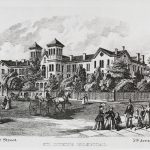
St. Luke’s Hospital on 5th Avenue
The Mount Sinai Hospital was not alone in its fascination with May for buildings. On May 21, 1857, the St. Luke’s Hospital chapel opened at the Hospital’s first site and a year later (May 13, 1858) the hospital itself opened at 5th Ave between 54th and 55th Streets.
The Woman’s Hospital in the State of New York, which became the Women’s Division of St. Luke’s Hospital in 1952, also had a May dedication tradition. On May 4, 1855 the Woman’s Hospital was opened at 83 Madison Avenue. Almost 50 years later, on May 17, 1904, the cornerstone was laid at a new site at Amsterdam Avenue and 110th Street.
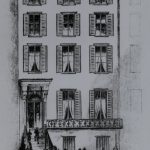
The first home of the Woman’s Hospital
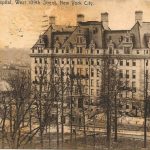
The 1904 west side Woman’s Hospital building
Finally, on May 25, 1965 the Woman’s Hospital opened in a separate building on the St. Luke’s campus on Amsterdam Avenue and 114th Street.
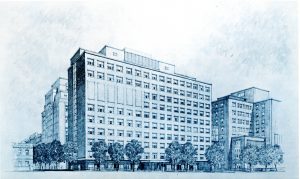
Apr 24, 2018
As the spring very slowly arrives, the tired mind often screams for relief from the challenge of processing complex information. So, here is some Mount Sinai trivia that is guaranteed to interest without straining the brain.
Did you know:
…that in the 17th century there were Native Americans living in East Harlem and there was a stream flowing where the Icahn building now stands?
…that the first year The Mount Sinai Hospital was opened (1855-56), we admitted 216 patients, only five of whom were born in the US, and three of them listed their careers as comedians?
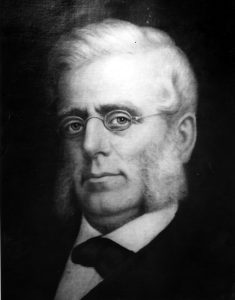
Mount Sinai founder, Benjamin Nathan
…that The Mount Sinai Hospital had a well regarded nursing school that existed from 1881-1971 and that 5 E. 98th Street was the School of Nursing dorm/educational building?
…that when the Hospital moved to its second site at Lexington Ave. and 66th St. in 1872, the Trustees built a large synagogue upstairs and a small operating room in the basement?
…that a Mount Sinai founder, Benjamin Nathan, was murdered in his sleep on a stormy night, and members of his family are still on the Board to this day?
…that Mount Sinai did not have an obstetrical service for the first century of its existence, only offering an OB Service when the Klingenstein Pavilion opened in late 1952?
…that there is a time capsule buried under the directory in the Annenberg Lobby that is scheduled to be opened in 2074, 100 years after it was placed there?
…that Jonas Salk and Henry Heimlich both served their internships at Mount Sinai, Salk graduating in 1942 and Heimlich in 1948?
…that in 1964, Mount Sinai had 1,326 beds, 200 more than we have today?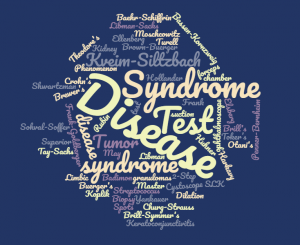
…that when the first ICU opened at Mount Sinai in 1962, it had five beds and was located in 1184 Fifth Ave., on the 7th floor?
…that in 1993 Mount Sinai School of Medicine became the first in New York State to graduate a class with more women than men?
…that there are at least 43 diseases, syndromes, tests, instruments and phenomena named after Mount Sinai physicians and scientists?



















